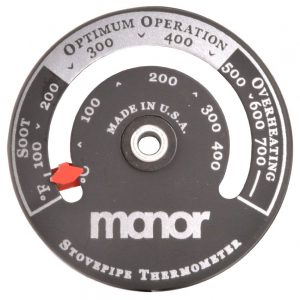It almost always comes as a shock to new wood burner or multi fuel stove owners that their baffle plate (also known as a throat or deflector plate) is classed as a stove ‘consumable’ and is therefore NOT covered under their stove warranty in the same way that most of the other components are.
This is because baffle plates are positioned at the top of the fire chamber specifically to deflect flames and heat back into the stove instead of letting them go straight through the flue system. And is partly why stoves are much more efficient at delivering heat to your room than an open fire.
However, it’s also why even on top quality stoves, baffle plates tend to burn out.
The Main Problem
Baffle plates are positioned at the hottest possible part of the stove and take the full brunt of the very high temperatures day-in and day-out. So whether your baffle plate is made of traditional cast iron, heavy steel plate, stainless steel or vermiculite board, you will eventually have to replace it.
How often this needs to happen depends on the type of fuel you burn, the size of the fuel load and how you burn your fuel.
Some stove owners can burn through their stove baffle plate in a matter of months and conversely some owners can make theirs last for years. A baffle plate on a boiler stove for example, will not tend to last as long as a baffle plate on a non-boiler stove. This is simply because boiler stoves generally need to be burned ‘harder’ over longer periods to maximise the heat to the hot water, especially when there are lots of central heating radiators connected to the system.
***As a matter of interest, smokeless mineral fuels (eg Anthracite Ovals) do not have the same flame height as an equivalent wood log load and can therefore be easier on a boiler stove baffle plate (but not necessarily on your CO2 emissions or our faces).***
The Consequences
If you regularly need to replace your stove baffle plate then you should review how you operate your stove by referring to your owners manual. It should contain advice on recommended fuel types and fuel loads, as well as instructions on how to effectively operate your stove. Quickly burning out a baffle plate means that you are probably not only wasting money on replacement baffle plates but also wasting money on fuel for sure.
***Chimney sweeps need to be able to remove the baffle plate so they can use the power sweeping equipment and clean effectively. *** If it is buckled and cannot be removed then I am in the unfortunate situation of having to charge a call out fee and you will need to call your installer out to remove & replace it.
Damaged baffle plates are increasingly more common these days, (which is one of the reasons for writing this article) creating speculation on the quality of metal materials nowadays. Also, often the installers fail to ensure the customer is sufficiently educated in the use and maintenance requirements of their appliance in the first place. Mostly though, it is users over filling beyond the stove load capacity.
The Cure
It is often the case that you are over loading and over-firing your stove and producing excess heat which is wasted through the flue system. An easy to use magnetic flue pipe thermometer will help you to monitor your flue gas temperature and can clearly indicate when you are over-firing your stove.
In my opinion a flue pipe thermometer is one of the best, ‘value for money’ stove accessories you could buy. It helps you to maximise the efficiency of your stove and also alerts you when your stove is potentially dangerous by being over or under fired.
It is very easy to abuse a stove and burn out a baffle plate within a single heating season by simply ignoring the manufacturer’s recommended fuels and operating instructions. Ergo, it’s also easy to see why most manufacturers now exclude baffle plates, fire grates, fire fences and glass from their normal warranty terms.

Figure 1 above shows a burned out cast iron baffle plate which is about three years old.
The owner used mainly softwood (it was free) which required a substantially bigger fuel load than the equivalent hardwood load needed to generate the same heat.
***This meant that the fuel and flames were too close to the baffle plate so the extremely high temperatures which were created, caused the baffle plate to warp and eventually fail (there is NO middle left).***
That particular stove had a rear fitted flue and it wasn’t until the owners noticed the flue pipe was glowing red that they realised they had any kind of problem.






You must be logged in to post a comment.